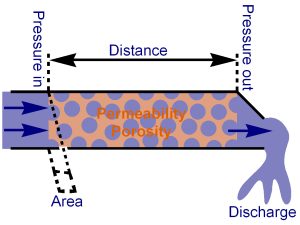Porosity and Permeability Calculator
With the porosity and permeability calculator, you'll be able to determine a medium's permeability and porosity by means of Darcy's law and volumes ratio, respectively.
In study fields such as hydrology, earth sciences, and petrophysics, how much fluid moves and how fast rely on various factors. Two essential parameters are the porosity and permeability of the medium.
We invite you to continue reading this text, where we will take a look at:
- Permeability definition;
- How to obtain the permeability formula from Darcy's law equation;
- What porosity is;
- How to calculate porosity and its equation; and
- The relationship between porosity and permeability.
Darcy's law and permeability equation
Permeability is a parameter that indicates how susceptible is a medium or material to the flow of a fluid through it. The higher a material's permeability, the easier it will be for a fluid to flow through it. Permeability depends on whether the pores are or are not connected and as well as the size of the pores.
To calculate permeability, we use Darcy's law. This equation describes the flow of a fluid (gas or liquid) through a porous medium (rocks, soil, sediments).
Darcy's law's most common applications are in the analysis of groundwater in aquifers, water, oil, and gas in petroleum reservoirs and other earth sciences applications. This is the Darcy's law equation:
where:
- - Discharge or flow rate, usually in m3/s or other volume per time units;
- - Permeability of the medium;
- - Cross-sectional area of the material;
- - Dynamic viscosity of the fluid;
- - Length travelled by the fluid; and
- - Pressure difference between either side of the material.

Notice from this formula that the higher the viscosity of a fluid, the harder it'll be for it to flow through the porous material. The rest of the equation's parameters are dependent on the medium's characteristics, e.g., density which is described more in detail in the .
From Darcy's law equation is possible to obtain an expression to calculate the permeability. By rearranging the previous formula:
This is the equation used by the porosity and permeability calculator.
Permeability is expressed in darcy (d) or millidarcy (ml). This unit represents a squared length (e.g., m2 or mm2). The conversion between squared meters and darcy is: 1 darcy is 9.87 × 10-13 m2.
How to calculate porosity
Let's see first what porosity is. Porosity is a relative measure of a material's void volume in relation to its total volume (solid plus void). This fraction of void is where fluids such as gas, water, oil, and others can accumulate. The greater a material's porosity, the more volume of fluid it can hold.
In general terms, porosity is calculated as the ratio of the void to the total volume of a medium. This is the porosity equation:
where:
- - Volume of void space; and
- - Total volume of the material.
Because we are comparing a fraction of total volume to total volume, the above will always return a dimensionless number between 0 and 1 or a percent.
The porosity relationship may alternatively be expressed in terms of the fluid discharge rate and its residence time in the medium as follows:
where:
- - Porosity of the material;
- - Discharge rate;
- - Time taken by the fluid to travel the distance ;
- - Cross-sectional area of the material; and
- - Distance the fluid travels through the material.
From the above, we can see that the higher the porosity of a material, the greater the discharge rate for a given volume of material.
It is important to note that porosity and permeability are related parameters. Both are linked to the number, size, and connectivity of materials' pores. The one influences the other and vice-versa. If the pores of a high porosity material are not connected, the material will have little to no permeability. Similarly, a low porosity material could have a high permeability if its pores communicate.